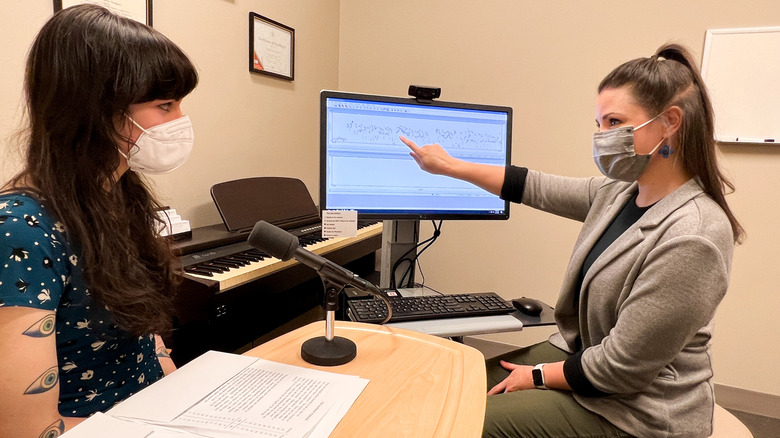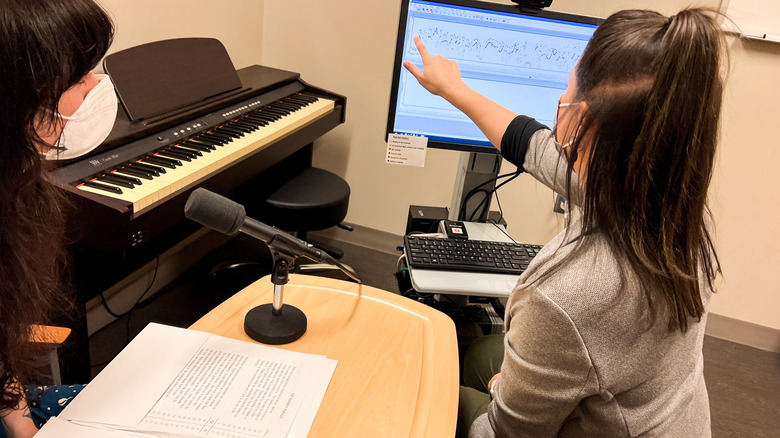Anna Lichtenstein, SLP, On What Trans People Should Know About Gender-Affirming Voice Therapy - Exclusive
For many trans people, the journey to self-acceptance is long and difficult. Even the simple act of identifying exactly why they feel wrong in the bodies they were born in can be daunting and fraught with negative blowback from family and community members. Taking the next steps — physically transforming their bodies to match their inner identities — is likewise a long and costly process with its own set of risks.
But even with successful surgical and hormonal treatments, many trans people — especially trans women — struggle to attain a gender-affirming voice. As speech pathologist Anna Lichtenstein explained, "Hormone treatment [has] no impact on the vocal tract. Because of this, all voice feminization is through training. I do have transmasculine patients on my caseload as well for various reasons, but it is not as common. Testosterone thickens up the vocal cords after around 3-6 months, causing them to vibrate at a slower frequency leading to a lower pitch."
In an exclusive interview with Health Digest, Lichtenstein shared some important dos and don'ts for trans people looking to modify their voices.
Don't believe everything you read online
When faced with challenges, we've all turned to the internet for help. But whether you're looking for remodeling advice or trying to achieve a gender-affirming voice, it pays to be careful what you believe. "There are some excellent online resources for gender-affirming voice; however, there is also alarming content. For some individuals, the online resources are exactly what people are looking for," Anna Lichtenstein said.
She warns against going it alone when cultivating your new voice. Even when working with reputable information, trying to modify your voice without professional support can lead to injury.
"I will note that unwanted damage to the vocal tract can occur with independent voice use depending on the method," she said. "Voice work should not feel painful, tight, straining, or too tiring. One of the benefits of having a voice therapist in front of you is the constant feedback, prompting, and adjusting." In short, if it doesn't feel comfortable and natural, you're risking injury.
Ask for what you want
Every trans person's journey is different, and according to Anna Lichtenstein, that translates to the speech therapy that may be right for them. She designs each patient's therapy to target their individual goals. "Some patients are seeking the ability to go stealth within society while others are seeking gender euphoria despite gender expression. Voice is very personal," she said. "To some, it is the most significant part of their transition journey. To others, their default voice is something they value and identify with. No two patients seeking gender-affirming care are the same."
This means that if you're seeking gender-affirming speech therapy, you should feel free to ask for what you want and work with your therapist to plan your therapy around your goals. Lichtenstein explained that a typical course of treatment in her clinic starts with an initial physical assessment of the throat and vocal cords by a laryngologist, followed by an introductory 90-minute session with her. "This 90-minute session allows for me to build rapport with the patient, discuss goals, measure quality of life impact, collect acoustics, and make a plan for therapy/training sessions," she said.
For more information, see the Wexner Medical Center at Ohio State University's site for gender-affirming care and James, S. E., Herman, J. L., Rankin, S., Keisling, M., Mottet, L., & Anafi, M. (2016). Statistics are taken from The Report of the 2015 U.S. Transgender Survey, Washington, DC: National Center for Transgender Equality.



